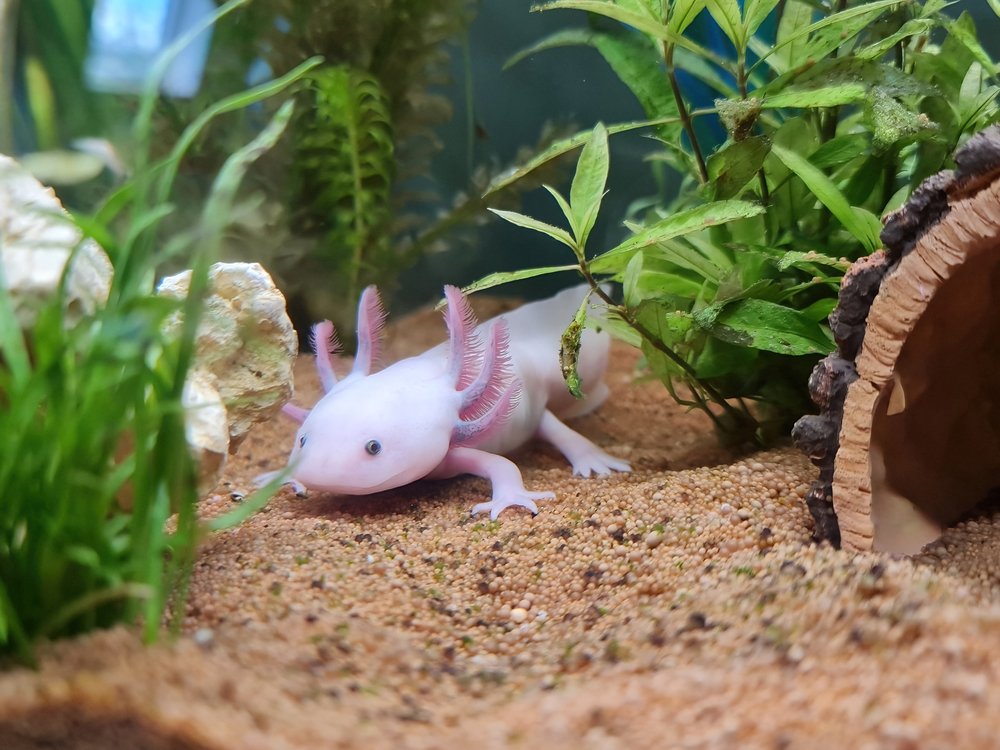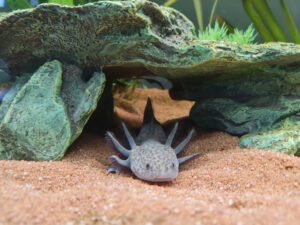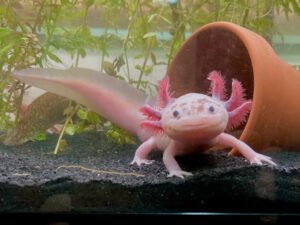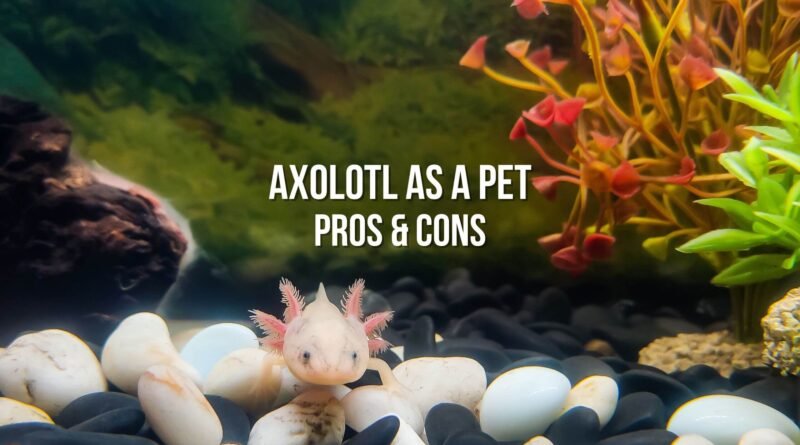Owning An Axolotl As a Pet: A Complete Guide
Axolotls are unique creatures that have been gaining popularity as pets in recent years. While they may not be the cuddliest animals, they are low-maintenance and can make for interesting companions. From limbs and jaws to skin and even parts of their brain, these aquatic creatures have astounded researchers with their incredible regenerative powers. This article delves into the captivating world of axolotls, exploring their regenerative capabilities, resistance to cancer, unique physical features, pronunciation, colors, and the challenges they face in the wild. Furthermore, we provide essential information for those interested in keeping axolotls as pets, including tank setup, feeding habits, breeding tips, and common health issues. Here, we will also explore some of the pros and cons of owning an axolotl as a pet so that you can make an informed decision about whether or not this is the right pet for you.




The Marvel of Regeneration
Axolotls have become the subject of extensive scientific studies due to their extraordinary regenerative abilities. They can regenerate any part of their body, making them the focus of research aimed at understanding the mechanisms behind this remarkable phenomenon. Limb regeneration, in particular, has attracted attention as it holds significant potential for medical advancements in the field of regenerative medicine. Successful regeneration in axolotls may pave the way for treatments benefiting individuals suffering from severe burns, limb loss, and even cancer. Researchers, such as Stephane Roy from the University of Montreal, recognize the importance of studying these amazing animals for the betterment of human health.
Axolotls and Cancer Resistance
Apart from their regenerative powers, axolotls possess another astonishing attribute—they are over 1,000 times more resistant to cancer than mammals. This inherent resistance to cancer has further intrigued scientists, who aim to uncover the biological mechanisms responsible for this unique trait. Studies conducted by researchers such as Roy and Lévesque have shed light on the super-healing abilities of axolotls, providing valuable insights into the potential applications in cancer research.
Neoteny: The Youthful Charm of Axolotls

In addition to their regenerative capacity, axolotls exhibit a phenomenon known as neoteny. This characteristic refers to the retention of juvenile features even after reaching sexual maturity. Axolotls maintain external gills and their unique appearance, resembling an elaborate feathered headdress, throughout their lives. Coupled with their small lidless black eyes and wide heads, these features make axolotls one of the most visually captivating creatures in the animal kingdom.
Pronunciation and Origins
The name “axolotl” originates from the Aztec language, Nahuatl, and is connected to the Aztec god Xolotl, associated with fire and lightning. Pronounced as “Ax-oh-lot-ul,” their scientific name is Ambystoma mexicanum, with “Ambystoma” translating to “cup mouth.” The Aztec legend of Xolotl transforming into an axolotl and hiding in the Mexican lakes adds a touch of mythology to the naming of these intriguing creatures.
A Colorful Array

Axolotls display a range of captivating colors. The five basic colors include Wild, Leucistic (known as Lucys), White Albino, Golden, and Melanoid. Each color variant possesses its own distinct beauty, with the Albino variety featuring pink or red eyes. In some parts of the United States, axolotls have been genetically modified to exhibit fluorescence under black light, a trait not found in their natural counterparts. However, it’s important to note that these modifications originated from scientific experiments.
The Plight of Axolotls in the Wild
Despite their remarkable qualities, axolotls face significant challenges in their natural habitat. Human intervention, including changes to the ecosystem and pollution, has led to a drastic decline in their population. Lake Xochimilco, once teeming with axolotls, has seen a devastating reduction in their numbers. A study conducted in 2003 reported an average of 6000 axolotls per square kilometer in the lake, but by 2015, that number had plummeted to a mere 36 per square kilometer. Consequently, the species was declared critically endangered in 2006, and it is highly likely that they are now extinct in the wild. However, dedicated conservation efforts by organizations like the Centre of Biological and Aquatic Research of Cuemanco (CIBAC) strive to maintain a small, isolated population within a quarantined area of the lake, ensuring the survival of these extraordinary creatures in their natural habitat.
Setting Up an Axolotl Tank
For those fascinated by axolotls and considering keeping them as pets, providing suitable living conditions is crucial for their well-being. Axolotls are native to Mexico and require specific conditions to thrive. Here are some essential tips for setting up an axolotl tank:
- Minimum tank size: Each adult axolotl requires a minimum of 10 gallons of water. For one axolotl, a tank with dimensions of around 50x30x20cm is recommended. If housing multiple axolotls, ensure each has a minimum of 10 gallons of water.
- Tank dimensions: Axolotls prefer long, low tanks with plenty of space to explore.
- Water temperature: Maintain the water temperature at 18°C, as temperatures above 24°C can cause distress and health issues. Investing in aquatic fans or a chiller can help regulate and cool the water.
- pH level: Aim for a stable pH level between 7.4 and 7.6, as fluctuating pH levels can be harmful to axolotls.
- Lighting: Axolotls prefer low lighting levels. Harsh lighting can be distressing for them, so opt for soft lighting and provide ample hiding places.
- Substrate: Sand is the best choice for the tank bottom, as it allows axolotls to dig and move comfortably. Avoid gravel, as it can pose a risk of digestive injury.
- Filtration system: A good filtration system is vital to maintain water quality. Avoid excessive water movement, as axolotls prefer still water conditions.
- Tank decor: Provide plants and caves in the tank to offer hiding places for axolotls. They enjoy exploring and seeking shelter.
Pros

To start, let’s go over some of the pros of getting an axolotl as a pet.
- Axolotls are low-maintenance pets that don’t require a lot of care.
- They are interesting to watch and can be great conversation starters.
- Axolotls are relatively long-lived, with some individuals living up to 15 years in captivity.
- They are relatively easy to find, as they are widely available from pet stores and online retailers.
- Axolotls are tolerant of a wide range of water conditions, making them ideal for beginner aquarists.
One of the biggest benefits of owning an axolotl is that they are relatively easy to care for. They are able to live in a wide range of environments, including freshwater tanks and bowls. They also don’t need to be fed very often; a diet of live food (such as worms or insects) once a week is typically sufficient.
Cons
Now, let’s review some items on the downside of having an axolotl as a pet.
- Axolotls are not the most cuddly pets and prefer to be left alone.
- They are escape artists and can squeeze through very small gaps, so they require a well-secured tank.
- They are carnivores and will eat smaller fish or invertebrates, so they should not be kept with other pets.
- Axolotls can secrete a toxic substance from their skin, so they should not be handled without gloves.
- They are sensitive to changes in water quality and temperature, so their tank needs to be monitored closely.
While axolotls are low-maintenance in terms of care, they can be messy eaters. When they feed, they often release excess food from their mouths, which can dirty their tank or bowl. If you decide to get an axolotl as a pet, be prepared to clean up after them on a regular basis.
Fun facts about the Axolotl
The axolotl, Ambystoma mexicanum, is a permanently aquatic salamander that can reach lengths of up to a foot. They are native to Mexico but have been introduced to other parts of the world through the pet trade. Here are some fun facts about these fascinating creatures!
- Axolotls have the ability to completely regenerate a lost limb. This process can take several months to complete.
- Axolotls are capable of completely regenerating their spinal cord if it is damaged.
- The axolotl has three main pair of gills and four smaller pairs on the sides of its head.
- Axolotls are carnivores and will eat just about anything they can fit in their mouths, including worms, insects, fish, and other amphibians.
- Adult axolotls typically range in color from black to brown, but they can also be albino or leucistic (lacking pigment).



Feeding Habits and Nutrition
Axolotls are carnivorous and have specific dietary requirements. Here’s what you need to know about feeding axolotls:
- Adult diet: Adult axolotls typically require two earthworms every 2-3 days. It’s essential to monitor their calorie intake and adjust the feeding schedule accordingly.
- Young axolotls: Juvenile axolotls have higher calorie requirements and may need to be fed daily. Offer them a variety of food, such as frozen bloodworms, small microforms, and live blackworms.
- Treats: Axolotls can enjoy treats like red wigglers, nightcrawlers, soft sinking salmon pellets, shrimp, prawns, mealworms, tuna, or even chicken. Treats should be given in moderation.
- Consistency is key: Ensure regular and consistent feeding to maintain optimal health. Young axolotls should not be left without food for more than three days, while adults can go up to two weeks without food, although this is not recommended.
Breeding Axolotls
Breeding axolotls can be a rewarding experience for enthusiasts. Here are some essential tips to keep in mind:
- Breeding age: Wait until your axolotls reach 18 months of age and adult size before attempting to breed them.
- Breeding season: The best breeding season is generally from December to June, although successful breeding can occur throughout the year.
- Breeding tank setup: Prepare a breeding tank with suitable conditions, including places for females to lay their eggs, such as silk or live plants, and stones for males to deposit their sperm.
- Egg laying and hatching: Females can lay as many as 1,000 eggs per spawning session. The breeding tank should be maintained at around 20°C. The eggs typically hatch within 2-3 weeks, and the hatchlings, known as axolotl larvae, emerge.
- Growth monitoring: As the hatchlings grow, it is important to monitor their size and separate larger ones to prevent them from preying on smaller ones.
Common Health Issues and Care
Axolotls are sensitive creatures, and proper care is essential to prevent health problems. Here are some common issues and care tips:
- Stress indicators: Lack of appetite, tail curling, and gills turning forward are signs of stress in axolotls.
- Injury and infection: Axolotls are capable of regenerating damaged body parts, but they are still susceptible to infection. Maintain clean water conditions when they are recovering from wounds.
- Impaction: Axolotls can experience digestive issues due to impaction, typically caused by ingesting gravel or stones. Ensure the substrate is safe and easily digestible to prevent impaction.
- Temperature-related illnesses: Axolotls can suffer from bacterial and fungal infections when exposed to high temperatures. Keep the water temperature stable and within the appropriate range to avoid these issues.
- Salt baths and fridging: Salt baths and fridging (lowering the water temperature) can be used as remedies for certain illnesses and infections. Consult a veterinarian or a knowledgeable expert for guidance and proper usage.
Conclusion
Whether or not an axolotl is the right pet for you depends on your individual circumstances and preferences. However, we hope that this overview of some of the pros and cons of owning an axolotl has helped you make a more informed decision about whether or not this is the right pet for you.




